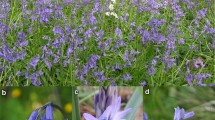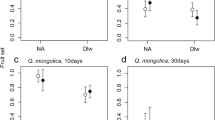Abstract
We evaluate postmating barriers to hybridization between an exotic eucalypt and a group of native congeners on the island of Tasmania. We aimed to better understand the basis of reproductive isolation between the species, glean insights into the evolution of isolating mechanisms, and inform genetic risk management. Compatibility between the exotic plantation species Eucalyptus nitens (pollen parent) and 18 native Tasmanian taxa was assayed using experimental crossing for 17 taxa (13,458 flowers pollinated to produce 1058 female × male cross combinations), and previous data for one species. Compatibility was assessed in terms of F1 hybrid production, as well as F1 hybrid survival and growth after 5 years. This data was combined with measurements of style length, and genetic distance from E. nitens to each maternal species, in order to determine the importance of a sequence of prezygotic and postzygotic barriers. We found that the early-acting barrier of style length (prezygotic) had the strongest isolating effect, while later-acting (postzygotic) barriers, affecting early-age growth and survival, contributed little to reproductive isolation. Style length alone explained 46 % of the variation in hybridization rate. Conversely, there was no significant relationship between genetic distance and prezygotic or postzygotic compatibility in these closely related species. This pattern is consistent with selection driving the rapid evolution of prezygotic barriers, while drift-like-processes lead to the more gradual evolution of intrinsic barriers. Although other premating and postmating barriers clearly contribute, our results highlight the important role of early-acting postmating barriers in preventing gene flow from exotic E. nitens plantations.


Similar content being viewed by others
References
Arnold ML, Tang S, Knapp SJ, Martin NH (2010) Asymmetric introgressive hybridization among Louisiana Iris species. Genes 1:9–22
Baack E, Melo MC, Rieseberg LH, Ortiz-Barrientos D (2015) The origins of reproductive isolation in plants. New Phytol. doi:10.111/nph.13424 doi:10.111/nph.13424
Barbour R, Potts BM, Vaillancourt RE, Tibbits WN, Wiltshire RJE (2002) Gene flow between introduced and native Eucalyptus species. New For 23:177–191
Barbour RC, Potts BM, Vaillancourt RE (2005a) Gene flow between introduced and native Eucalyptus species: crossability of native Tasmanian species with exotic E. nitens. Aust J Bot 53:465–477
Barbour RC, Potts BM, Vaillancourt RE (2005b) Pollen dispersal from exotic eucalypt plantations. Conserv Genet 6:253–257
Barbour RC, Potts BM, Vaillancourt RE (2006a) Gene flow between introduced and native Eucalyptus species: early-age selection limits invasive capacity of exotic E. ovata × nitens F1 hybrids. For Ecol Manag 228:206–214
Barbour RC, Potts BM, Vaillancourt RE, Tibbits WN (2006b) Gene flow between introduced and native Eucalyptus species: flowering asynchrony as a barrier to F1 hybridisation between exotic E. nitens and native Tasmanian Symphyomyrtus species. For Ecol Manag 226:9–21
Barbour RC, Otahal Y, Vaillancourt RE, Potts BM (2008) Assessing the risk of pollen-mediated gene flow from exotic Eucalyptus globulus plantations into native eucalypt populations of Australia. Biol Conserv 141:896–907. doi:10.1016/j.biocon.2007.12.016
Barbour RC, Wise SL, McKinnon GE, Vaillancourt RE, Williamson GJ, Potts BM (2010) The potential for gene flow from exotic eucalypt plantations into Australia’s rare native eucalypts. For Ecol Manag 260:2079–2087. doi:10.1016/j.foreco.2010.08.049
Boland DJ, Brooker MIH, Chippendale GM, Hall N, Hyland BPM, Johnston RD, Kleinig DA, Turner JD (1985) Forest trees of Australia. Australian Government Publishing Service, Melbourne
Brooker MIH (2000) A new classification of the genus Eucalyptus L'Her. (Myrtaceae). Aust Syst Bot 13:79–148
Byrne M (2008a) Evidence for multiple refugia at different time scales during Pleistocene climatic oscillations in southern Australia inferred from phylogeography. Quat Sci Rev 27:2576–2585
Byrne M (2008b) Phylogeny, diversity and evolution of eucalypts. In: Plant Genome: Biodiversity and Evolution. Volume 1, Part E, Phanerogams-Angiosperm. Science Publishers Enfield, pp 303–346
Chae E, Bomblies K, Kim S-T et al (2014) Species-wide genetic incompatibility analysis identifies immune genes as hot spots of deleterious epistasis. Cell 159:1341–1351
Costa e Silva J, Potts BM, Tilyard P (2012) Epistasis causes outbreeding depression in eucalypt hybrids. Tree Genet Genom 8:249–265
Coyne JA, Orr HA (1989) Patterns of speciation in Drosophila. Evolution 43:362–381
Coyne JA, Orr HA (1997) “Patterns of speciation in Drosophila” revisited. Evolution 51:295–303
Coyne JA, Orr AH (2004) Speciation. Sinauer, Massachusetts
Desper R, Gascuel O (2002) Fast and accurate phylogeny reconstruction algorithms based on the minimum-evolution principle. J Comput Biol 9:687–705
Emms SK, Hodges SA, Arnold ML (1996) Pollen-tube competition, siring success, and consistent asymmetric hybridization in Louisiana irises. Evolution 2201–2206
Gore PL, Potts BM, Volker PW, Megalos J (1990) Unilateral cross-incompatibility in Eucalyptus: the case of hybridisation between E. globulus and E. nitens. Aust J Bot 38:383–394
Grattapaglia D, Vaillancourt RE, Shepherd M et al (2012) Progress in Myrtaceae genetics and genomics: Eucalyptus as the pivotal genus. Tree Genet Genom 8:463–508
Griffin AR, Burgess IP, Wolf L (1988) Patterns of natural and manipulated hybridization in the genus Eucalyptus L'Herit: a review. Aust J Bot 36:41–66
Hamilton MB (1999) Tropical tree gene flow and seed dispersal. Nature 401:129–130
Hamilton M, Joyce K, Williams D, Dutkowski G, Potts B (2008) Achievements in forest tree improvement in Australia and New Zealand 9. Genetic improvement of Eucalyptus nitens in Australia. Aust For 71:82–93
Hatfield T, Schluter D (1999) Ecological speciation in sticklebacks: environment-dependent hybrid fitness. Evolution 866–873
Hingston AB, Gartrell BD, Pinchbeck G (2004a) How specialized is the plant-pollinator association between Eucalyptus globulus ssp. globulus and the swift parrot Lathamus discolor? Austral Ecol 29:624–630
Hingston AB, McQuillan PB, Potts BM (2004b) Pollinators in seed orchards of Eucalyptus nitens (Myrtaceae). Aust J Bot 52:209–222
Hogenboom N, Mather K (1975) Incompatibility and incongruity: two different mechanisms for the non-functioning of intimate partner relationships. Proc R Soc Lond Ser B Biol Sci 188:361–375
Hopkins R (2013) Reinforcement in plants. New Phytol 197:1095–1103
Jewell C, Papineau AD, Freyre R, Moyle LC (2012) Patterns of reproductive isolation in Nolana (Chilean Bellflower). Evolution 66:2628–2636
Johansen-Morris A, Latta RG, Mauricio R (2006) Fitness consequences of hybridization between ecotypes of Avena barbata: hybrid breakdown, hybrid vigor, and transgressive segregation. Evolution 60:1585–1595
Kremer A, Ronce O, Robledo-Arnuncio JJ et al (2012) Long-distance gene flow and adaptation of forest trees to rapid climate change. Ecol Lett 15:378–392. doi:10.1111/j.1461-0248.2012.01746.x
Larcombe MJ, Barbour RC, Vaillancourt RE, Potts BM (2014) Assessing the risk of exotic gene flow from Eucalyptus globulus plantations to native E. ovata forests. For Ecol Manage 312:193–202. doi:10.1016/j.foreco.2013.10.005
Larcombe MJ, Holland B, Steane DA, Jones RC, Nicolle D, Vaillancourt RE, Potts BM (2015) Patterns of reproductive isolation in Eucalyptus—a phylogenetic perspective. Mol Biol Evol. doi:10.1093/molbev/msv063
Lepais O, Roussel G, Hubert F, Kremer A, Gerber S (2013) Strength and variability of postmating reproductive isolating barriers between four European white oak species. Tree Genet Genom 9:841–853
Levin DA (1978) The origin of isolating mechanisms in flowering plants. Evol Biol 11:185–317
Levin DA (2012) The long wait for hybrid sterility in flowering plants. New Phytol 196:666–670
Lopez GA, Potts BM, Tilyard PA (2000) F1 hybrid inviability in Eucalyptus: the case of E. ovata x E. globulus. Heredity 85:242–250
Lowry DB, Modliszewski JL, Wright KM, Wu CA, Willis JH (2008) The strength and genetic basis of reproductive isolating barriers in flowering plants. Philos Trans R Soc B 363:3009–3021
Martin NH, Willis JH (2007) Ecological divergence associated with mating system causes nearly complete reproductive isolation between sympatric Mimulus species. Evolution 61:68–82
Matute DR, Butler IA, Turissini DA, Coyne JA (2010) A test of the snowball theory for the rate of evolution of hybrid incompatibilities. Science 329:1518–1521
McKinnon GE, Vaillancourt RE, Steane DA, Potts BM (2008) An AFLP marker approach to lower-level systematics in Eucalyptus (Myrtaceae). Am J Bot 95:368–380
Moyle LC, Nakazato T (2010) Hybrid incompatibility “snowballs” between Solanum species. Science 329:1521–1523
Moyle LC, Olson MS, Tiffin P (2004) Patterns of reproductive isolation in three angiosperm genera. Evolution 58:1195–1208
Myburg AA, Vogl C, Griffin AR, Sederoff RR, Whetten RW (2004) Genetics of postzygotic isolation in Eucalyptus: whole-genome analysis of barriers to introgression in a wide interspecific cross of Eucalyptus grandis and E. globulus. Genetics 166:1405–1418
Myburg AA, Grattapaglia D, Tuskan GA et al (2014) The genome of Eucalyptus grandis. Nature 510:356–362
Nicolle D (2015) Classification of the eucalypts (Angophora,Corymbia and Eucalyptus) Version 2. http://www.dn.com.au/Classification-Of-The-Eucalypts.pdf. Accessed 4/08/2015
Nikles DG, Newton RS Correlations of breeding values in pure and hybrid populations of hoop pine and some southern pines in Queensland and relevance to breeding strategies. In: Proceedings of the 12th Meeting of the Research Working Group 1 of the Australian Forestry Council, Coonawarra, South Australia, March 1991 1991. pp 1–5
Orr HA, Turelli M (2001) The evolution of postzygotic isolation: accumulating Dobzhansky-Muller incompatibilities. Evolution 55:1085–1094
Owens GL, Rieseberg LH (2014) Hybrid incompatibility is acquired faster in annual than in perennial species of sunflower and tarweed. Evolution 68:893–900
Potts BM, Marsden-Smedley JB (1989) In vitro germination of Eucalyptus pollen: response to variation in boric acid and sucrose. Aust J Bot 37:429–441
Potts BM, Barbour RC, Hingston A, Vaillancourt RE (2003) Turner Review No. 6: Genetic pollution of native eucalypt gene pools—identifying the risks. Aust J Bot 51:1–25
Pound LM, Wallwork MAB, Potts BM, Sedgley M (2002) Self-incompatibility in Eucalyptus globulus ssp. globulus (Myrtaceae). Aust J Bot 50:365–372
Pryor LD, Johnson LAS (1981) Eucalyptus, the universal Australian. In: Keast A (ed) Ecological Biogeography of Australia. W. Junk, The Hague, pp 499–536
Rathcke B (1983) Competition and facilitation among plants for pollination. Pollination Biol 305–329
Savolainen O, Pyhäjärvi T, Knürr T (2007) Gene flow and local adaptation in trees. Annu Rev Ecol Evol Syst 595–619
Scopece G, Musacchio A, Widmer A, Cozzolino S (2007) Patterns of reproductive isolation in Mediterranean deceptive orchids. Evolution 61:2623–2642
Sedgley M, Granger L (1996) Embryology of Eucalyptus spathulata and E. platypus (Myrtaceae) following selfing, crossing and reciprocal interspecific pollination. Aust J Bot 44:661–671
Seehausen O, Butlin RK, Keller I et al (2014) Genomics and the origin of species. Nat Rev Genet 15:176–192
Sicard A et al. (2015) Divergent sorting of a balanced ancestral polymorphism underlies the establishment of gene-flow barriers in Capsella. Nat Commun 6
Steane DA, Nicolle D, McKinnon GE, Vaillancourt RE, Potts BM (2002) Higher-level relationships among the eucalypts are resolved by ITS-sequence data. Aust Syst Bot 15:49–62
Steane DA, Nicolle D, Sansaloni CP et al (2011) Population genetic analysis and phylogeny reconstruction in Eucalyptus (Myrtaceae) using high-throughput, genome-wide genotyping. Mol Phylogen Evol 59:206–224
Stelkens RB, Young KA, Seehausen O (2010) The accumulation of reproductive incompatibilities in African cichlid fish. Evolution 64:617–633
Tiffin P, Olson S, Moyle LC (2001) Asymmetrical crossing barriers in angiosperms. Proc R Soc Lond B Biol Sci 268:861–867
Volker PW, Potts BM, Borralho NMG (2008) Genetic parameters of intra- and inter-specific hybrids of Eucalyptus globulus and E. nitens. Tree Genet Genom 4:445–460. doi:10.1007/s11295-007-0122-0
Widmer A, Lexer C, Cozzolino S (2009) Evolution of reproductive isolation in plants. Heredity 102:31–38
Williams K, Potts BM (1996) The natural distribution of Eucalyptus species in Tasmania. Tasforests 8:39–164
Woodhams M, Steane DA, Jones RC, Nicolle D, Moulton V, Holland BR (2013) Novel distances for Dollo data. Syst Biol 62:62–77
Zamir D, Tanksley S, Jones R (1981) Low temperature effect on selective fertilization by pollen mixtures of wild and cultivated tomato species. Theor Appl Genet 59:235–238
Zuur AF, Ieno EN, Walker NJ, Saveliev AA, Smith GM (2009) Mixed effects models and extensions in ecology with R. Springer Verlag
Acknowledgments
We thank the two anonymous reviewers for their helpful comments. We thank Paul Tilyard, Scott Nichols, and Justin Bloomfield for their assistance with field work. This research was funded by the Australian Research Council (Discovery Grants DP130104220, DP0986491, and DP0770506).
Data archiving
Data is available at the University of Tasmania, Open Repository <eprints.utas.edu.au>. Included are: the complete cross level dataset; species level genetic distances; and model parameters including habitat type and area occupied.
Author information
Authors and Affiliations
Corresponding author
Ethics declarations
Conflict of interest
The authors declare that they have no conflicts of interest.
Additional information
Communicated by D. Grattapaglia
Rights and permissions
About this article
Cite this article
Larcombe, M.J., Barbour, R.C., Jones, R.C. et al. Postmating barriers to hybridization between an island’s native eucalypts and an introduced congener. Tree Genetics & Genomes 12, 26 (2016). https://doi.org/10.1007/s11295-016-0979-x
Received:
Revised:
Accepted:
Published:
DOI: https://doi.org/10.1007/s11295-016-0979-x




